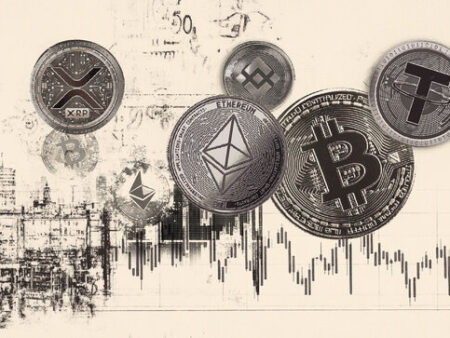Top Cryptocurrencies to Watch in July
Last month’s list capitalized on the momentum from the Pectra upgrade, implemented on May 7th, considered the most significant technical advancement since The Merge. We highlighted assets directly linked to the Ethereum ecosystem.
ETH responded with a 12% increase between June 8th and 10th, just over a month after the update, also boosting two other coins included in the list: Uniswap (+37%) and Aave (+14%).
This movement reinforces the strong correlation between the token and the applications operating on its base.
Even Cardano and Polkadot, with more modest gains that we included in the June list, maintain solid fundamentals and could benefit as Ethereum innovations gain traction.
Selection Criteria
For July, focusing on a significant trend in the crypto market, the Research team at Coinext concentrated on cryptocurrencies that are consolidating as real payment infrastructures: networks that combine near-symbolic fees, confirmations in seconds, and direct integration with the traditional financial system.
This transformation is already mobilizing giants like Visa and Mastercard, which are forging partnerships to enable on-chain purchases, driving mass adoption, and bringing the crypto universe closer to the daily lives of millions of people globally.
We selected projects with the potential to transform the daily use of cryptocurrencies, making them efficient and accessible platforms for payments, thanks to their advanced technology and growing institutional adoption. These networks function as bridges between the digital world and the traditional financial system. As a result, they not only expand financial inclusion but also drive usage, increase transactions, and strengthen the valuation of tokens in a more sustainable way.
Ripple (XRP)
Ripple (XRP) is the native cryptocurrency of the XRP Ledger, created in 2012 by Ripple Labs to enable near-instant international transfers with minimal costs. Instead of mining, the XRP Ledger’s federated consensus protocol validates transactions in seconds for less than $0.001, attracting financial institutions that need fast and efficient settlement between various assets.
Now, XRP’s efficiency extends beyond its own network. Thanks to the integration of the Wormhole system, you can transfer XRP, stablecoins, and even real-world assets (such as “tokenized” real estate) directly between more than 35 networks, from Ethereum to Solana and Avalanche, quickly, cheaply, and within the rules.
This set of improvements should increase the real-world use of XRP, attract more institutional investors, and create solid demand that could boost the token’s valuation.
At the same time, the prospect of an IPO for Ripple gains strength as the dispute with the SEC heads towards a resolution. Inspired by Circle’s valuation jump from $5 billion to $63 billion after its IPO, lawyer John Deaton projects that Ripple could reach a $100 billion valuation, which should also boost the price of XRP.
Projections point to levels above $10, with more optimistic scenarios of up to $100, consolidating the cryptocurrency as a strategic asset for both payments and investment.
Stellar Lumens (XLM)
Stellar Lumens (XLM) is the native cryptocurrency of the Stellar Network, created in 2014 by Jed McCaleb (co-founder of Ripple) to make cross-border payments fast, cheap, and accessible to individuals and institutions. Based on the Stellar Consensus Protocol (SCP), the network processes transactions in seconds, making it ideal for micropayments, issuance of tokenized assets, and international remittances. McCaleb’s vision for interoperability and financial inclusion makes Stellar an efficient bridge between different currencies and payment systems.
On June 18th, Valour (a subsidiary of DeFi Technologies that creates simple financial products for crypto assets) launched a Stellar (XLM) ETP (Exchange Traded Product) on the Spotlight Stock Market in Sweden. This “exchange-traded fund” follows the price of XLM and can be bought or sold like a common stock, without the need for digital wallets.
With periodic audits, secure custody, and transparent quotation in Swedish krona, the ETP attracts traditional investors, increases the liquidity of XLM, and generates price support that can favor its sustainable valuation.
Data shows that, in June, the total value locked (TVL) in Stellar protocols reached a record of $97.7 million, reflecting greater use of the network. The market capitalization of stablecoins issued on Stellar also rose, reaching $650.5 million, reinforcing interest in stable payment solutions.
In the derivatives market, the funding rate for XLM turned positive, which means there are more bets on the rise than on the fall, a classic sign of optimism.
With an ETP on the stock exchange expanding liquidity, a record TVL, and an upward bias in derivatives, we believe that Stellar (XLM) has strong potential for appreciation in July.
Tron (TRX)
Tron (TRX) was born in 2017, conceived by Justin Sun to decentralize the digital entertainment industry. Its Delegated Proof of Stake (DPoS) consensus mechanism allows it to process thousands of transactions per second, making the network attractive for dApps, on-chain games, streaming services, and even DeFi protocols.
This combination of speed and low cost consolidates Tron as a scalable and economical platform, a key point for the demand for TRX, as the intense use of the network generates fee revenue and reinforces the value of the token. In June, the network recorded a peak of more than 4.5 million daily users (DAU), almost double the average of the previous two months, driven mainly by new entrants.
This jump indicates strong interest and mass adoption, which usually reflects in an increase in transactions and, consequently, revenue for the network. However, the rapid drop in long-term retention points to a challenge: keeping these users active is essential to sustain the growth of TRX, as an engaged ecosystem generates greater utility and value for the token.
Another indicator of Tron’s success is the supply of USDT: surpassing $80 billion in stablecoins puts it ahead of all other blockchains in this market, demonstrating confidence from major issuers and high demand for liquidity.
In parallel, the volume traded on DEXs rose from $4.9 billion in April to $5.5 billion in May, signaling a resumption of on-chain activity. Together, these numbers reinforce Tron’s practical relevance as a liquidity and payments hub, creating solid support for TRX.
Currently, the price oscillates between support at $0.270 and resistance at $0.273–0.275. If buyers manage to sustain the support level with increased volume, the next technical target is at $0.28.
Despite still being 36% below the peak of $0.4313 reached in December 2024, this lateral consolidation near buying levels, combined with the continued growth in the use of USDT on the network, signals that TRX may be at an inflection point.
If the ecosystem maintains its current traction and resolves its retention challenges, there is a good chance of seeing a consistent recovery in the coming months.
Therefore, we see Tron (TRX) as a promising option for July, bringing together robust network fundamentals and favorable market conditions for sustainable appreciation.
Worldcoin (WLD)
Worldcoin (WLD) is the native token of the World ID protocol, created by Tools for Humanity with support from Sam Altman, co-founder of OpenAI. The project combines a cryptocurrency and an identity verification system based on eye biometrics (“Orb”): users scan their iris to prove they are unique people without revealing personal data, receive a World ID, and then can claim their WLD airdrop.
This dual layer, token and decentralized identity, aims to foster a more inclusive digital economy, preventing multi-account fraud and ensuring fair distribution of the asset on a global scale.
Worldcoin (WLD) is in negotiations with Visa to enable stablecoin payments directly in the World Wallet. The partnership aims to expand the wallet to include crypto identity verification, currency exchange, and fiat currency deposits, leveraging Visa’s vast network of merchants.
For WLD, this means transforming the World Wallet into a complete financial hub, mixing traditional functions, such as currency conversion and fiat on-ramps, with secure and decentralized crypto capabilities. By facilitating the daily use of stablecoins and offering access to Visa’s global infrastructure, the adoption of Worldcoin tends to accelerate, increasing demand for the WLD token and reinforcing its role as a bridge between conventional finance and the digital economy.
Furthermore, Tools for Humanity wants to expand its base of human users by verifying irises with the “Orb” and prioritizing their transactions on the Worldchain via PBH (“Priority Blockspace for Humans”), in addition to allocating $1 million in WLD to incentivize developers. With 13 million IDs issued and 100 million verifications, the PBH is in testnet, a parallel test network that replicates the main network without real value risks, allowing validation of new functions before the official launch. This proof of humanity increases the utility of WLD, as verified users pay lower fees and have higher priority.
According to analysis, Worldcoin (WLD) faces a persistent bearish moment, with prices struggling to stay above $0.85 and forming increasingly lower highs and lows.
Despite this scenario, the stabilization around $0.85 without a significant increase in sales suggests a possible accumulation zone and, for those looking for opportunities at a discounted level, WLD may offer an attractive entry point.
With strategic partnerships, such as the future integration with Visa, and exclusive innovations of proof of humanity via Orb and PBH, Worldcoin tends to accelerate the adoption of the World Wallet and increase the demand for WLD.
In addition, the price consolidation around $0.85 configures an attractive accumulation window, offering a discounted entry point before the next value catalysts.
Chainlink (LINK)
Chainlink (LINK) is the native token of a decentralized oracle network, which serves as a bridge between smart contracts on blockchains and real-world data, such as market prices, sports results, or weather information, securely and reliably.
Launched in 2017 by Sergey Nazarov, the protocol works through independent node operators who collect off-chain data and deliver it on-chain, ensuring integrity, censorship resistance, and reliability. Developers pay these nodes in LINK, creating an economic incentive for them to maintain and expand this infrastructure. This oracle layer is essential for use cases in DeFi, parametric insurance, on-chain games, and any application that depends on accurate external data.
Chainlink has partnered with Mastercard to allow more than 3 billion cardholders to buy cryptocurrencies directly on-chain through a single, regulated flow of traditional currency to crypto conversion.
The solution integrates a compliance and custody provider, a payment processor, and decentralized liquidity platforms, allowing exchanges to occur in seconds, without having to resort to multiple intermediaries.
With this, users will be able to, in a few clicks, acquire digital assets in their on-chain wallet using the same card as always, reducing friction and increasing accessibility to the crypto ecosystem.
By removing technical and regulatory barriers, this initiative has the potential to accelerate the mass adoption of cryptocurrencies, integrating traditional payments and decentralized finance into a fluid and secure experience. Following the announcement, Chainlink’s native token, LINK, jumped about 14%, reaching $13.37.
According to reports, LINK bottomed out at $11.00 in the last week of June and recovered in “V” to resistance at $13.50. Now, it oscillates between support at $13.00 and resistance at $13.50.
Due to its leading position as an essential oracle infrastructure, the recent acceleration of adoption via the partnership with Mastercard, Chainlink (LINK) is consolidated as one of the best cryptocurrencies to include in the July portfolio.
Stay ahead of the curve in the fast-paced crypto world – explore the latest updates and trends at Cryptonewsfeeds.com.










